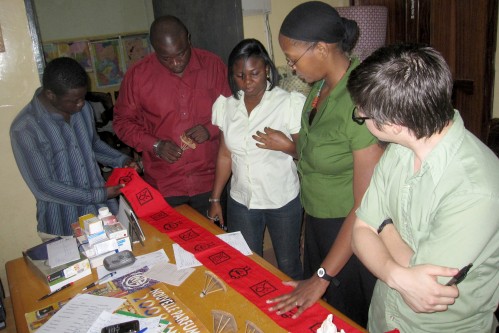 PROFESSOR AUDREY BENNETT AND GRADUATE STUDENT DAVID BANKS ASK for feedback on a graphic design using indigenous communication forms.
PROFESSOR AUDREY BENNETT AND GRADUATE STUDENT DAVID BANKS ASK for feedback on a graphic design using indigenous communication forms.As part of the National Science Foundation’s Graduate STEM Fellows in K-12 Education Program, Rensselaer’s Triple Helix Program has pioneered research programs in low-income communities including Albany and Ghana. Their goal is to pursue technical research in these areas that receive less attention (compared to the more common military and industrial applications), and to leverage that relevency to increase students’ interest in science and mathematics. The program includes eight graduate students—three in computer science, two in science and technology studies, two in electrical, computer, and systems engineering, and one in biomedical engineering.
“It’s not just going to these low-income communities and solving [their problems] with our magic technology,” said Professor of Science and Technology Studies Ron Eglash, the principal investigator for 3Helix. They’re doing actual research solving new problems, he explained. He pointed to the joint work of graduate students Chris Shing, Louis Gutierrez, and Kirk Jalbert on the Community Sensor Project, an open source venture in both hardware and software. At Diné College in the Navajo Nation, the sensor project was adapted to detect volatile organic compounds (such as formaldehyde). Meanwhile, the open source component is being promoted as part of middle school science curriculums in Albany by supplying them with sensor kits.
Other projects were more cases of applied engineering, said Eglash, such as 3Helix’s HIV prevention efforts in Africa. Associate Professor of Language, Literature, and Communication Audrey Bennett and graduate student David Banks traveled to Ghana. Their plan was to develop a modem that would reply to texts with the location of the nearest place to buy condoms, captializing on the widespread ownership of cell phones in the area. The results weren’t as good as expected, though. “What we found was that folks already knew where to buy condoms, at the pharmacies,” said Eglash. The problem, he elaborated, was the embarrassment—women didn’t want to be seen buying them. This summer, they’ll be going back with vending machines to put in women’s restrooms. In addition, they are embedding modems in the machines to notify suppliers when they are empty. There are a lot of other little issues left to iron out, such as how to power the machines.
“Another one of my favorite projects is a collaboration between a CS student and an STS student,” said Eglash. Culturally Situated Design Tools is a set of web applets designed by CS graduate student Bill Babbit and STS graduate student Dan Lyles. The software simulates familiar cultural artifacts on the screen to help teach grade school children the basics of computing and mathematics. For example, at Ayeduase Junior High School in Ghana, they demoed an application mimicked weaving traditional kente cloth. For Navajo Nation schools, they developed a rug simulation. “And what’s the indigenous art of low-income families in Albany? Graffiti!” said Eglash. The inclusion of cultural themes had statistically significant benefits—in a study with two sections of the same class taught by the same teacher, the section that used 3Helix’s Culturally Situated Design Tools performed noticably better than the other section, which used a different web-based learning tool without any cultural tie-ins. Several of the tools are available online at http://csdt.rpi.edu/.
Graduate student Tian Gao and Sam Seifert ’12 are also working on software to help kids learn math, using Microsoft’s Kinect sensor to interact with a computer program. “The one that really caught my eye was the equation balancer,” commented Eglash. The user appears as a stick figure on the screen, controlled by their motion in real life, and can move variables and constants from one side of an equation to the other. Unlike the culutural tools, there isn’t yet any data showing whether or not this actually helps kids learn algebra. “But that’s why it’s science,” said Eglash.
More information is available on the internet at http://www.3helix.rpi.edu/, including videos of the Equation Handler under “Program Highlights.”
